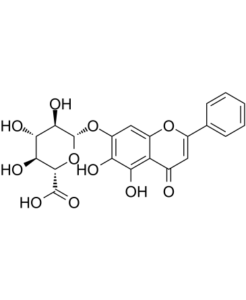Baicalin
This product is for research use only, not for human use. We do not sell to patients.

For small sizes, please check our retail website as below: www.invivochem.com
| Size | Price | Stock |
|---|---|---|
| 10g | $130 | In Stock |
| 20g | $195 | In Stock |
| 50g | $310 | In Stock |
Cat #: V12272 CAS #: 21967-41-9 Purity ≥ 98%
Description: Baicalin is naturally occuring flavonoid glycoside found in several species in the genus Scutellaria, including Scutellaria lateriflora (blue skullcap).
Top Publications Citing Invivochem Products
Publications Citing InvivoChem Products
Product Promise

- Physicochemical and Storage Information
- Protocol
- Related Biological Data
- Stock Solution Preparation
- Quality Control Documentation
| Molecular Weight (MW) | 446.36 |
|---|---|
| Molecular Formula | C21H18O11 |
| CAS No. | 21967-41-9 |
| Protocol | In Vitro | Baicalin prevents ischemia-reperfusion injury (IRI) by altering the production of various mediators, including reactive oxygen species (ROS), Toll-like receptors (TLR)2 and TLR4, NF-κB, Bax, and Bcl-2. Baicalin treatment inhibits increased expression of pro-inflammatory cytokines TLR2/4, MyD88, p-NF-κB, and p-IκB, as well as increased expression of NF-κB inhibitor IκB protein |
|---|---|---|
| In Vivo | Baicalin preinhibitor doses dependently prevent loss of renal function, with two higher doses (10 and 100 mg/kg) significantly reducing Scr and blood urea nitrogen (BUN) concentrations. Tissue damage assessed using a 0- to 3-point scoring system was lower in the Baicalin-treated group than in the ischemia-reperfusion (IR) + saline group. Compared with the sham group, malondialdehyde (MDA) content in rats treated with 10 and 100 mg/kg Baicalin was only slightly upregulated and SOD activity was only slightly down-regulated, indicating that Baicalin eliminated the increase in oxidative stress after reperfusion |
These protocols are for reference only. InvivoChem does not
independently validate these methods.
| Solvent volume to be added | Mass (the weight of a compound) | |||
|---|---|---|---|---|
| Mother liquor concentration | 1mg | 5mg | 10mg | 20mg |
| 1mM | 2.2403 mL | 11.2017 mL | 22.4034 mL | 44.8069 mL |
| 5mM | 0.4481 mL | 2.2403 mL | 4.4807 mL | 8.9614 mL |
| 10mM | 0.2240 mL | 1.1202 mL | 2.2403 mL | 4.4807 mL |
| 20mM | 0.1120 mL | 0.5601 mL | 1.1202 mL | 2.2403 mL |
The molarity calculator equation
Mass(g) = Concentration(mol/L) × Volume(L) × Molecular Weight(g/mol)
Mass
=
Concentration
×
Volume
×
Molecular Weight*
The dilution calculator equation
Concentration(start)
×
Volume(start)
=
Concentration(final)
×
Volume(final)
This equation is commonly abbreviated as: C1 V1 = C2 V2
Concentration(start)
C1
×
Volume(start)
V1
=
Concentration(final)
C2
×
Volume(final)
V2
Step One: Enter information below
Dosage mg/kg
Average weight of animals g
Dosing volume per animal µL
Number of animals
Step Two: Enter the in vivo formulation
%DMSO
+
%
+
%Tween 80
+
%ddH2O
Calculation Results:
Working concentration:
mg/ml;
Method for preparing DMSO master liquid:
mg
drug pre-dissolved in
µL
DMSO(Master liquid concentration
mg/mL)
,Please contact us first if the concentration exceeds the DMSO solubility of the batch of drug.
Method for preparing in vivo formulation:
Take
µL
DMSO master liquid, next add
µL
PEG300, mix and clarify, next add
µL
Tween 80,mix and clarify, next add
µL
ddH2O,mix and clarify.
Note:
- (1) Please be sure that the solution is clear before the addition of next solvent. Dissolution methods like vortex, ultrasound or warming and heat may be used to aid dissolving.
- (2) Be sure to add the solvent(s) in order.




































